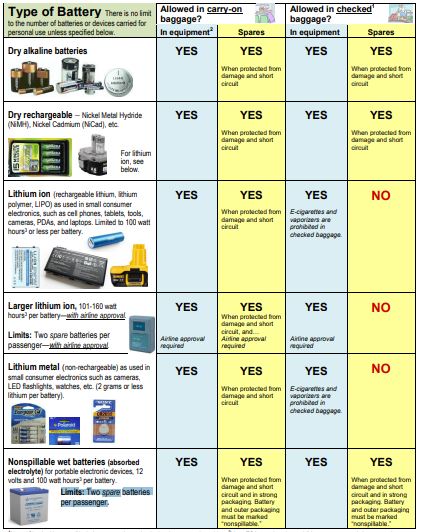https://www.faa.gov/hazmat/packsafe/resources/media/Airline_passengers_and_batteries.pdf
https://www.tsa.gov/travel/security-screening/whatcanibring/all?combine=batteries&page=1#:~:text=Lithium%20batteries%20with%20100%20watt%20hours%20or%20less%20in%20a%20device&text=Spare%20(uninstalled)%20lithium%20ion%20and,grams%20of%20lithium%20per%20battery.
What Batteries are allowed to the Aircraft Cabin in Carry-on baggage?
- Dry cell alkaline batteries
- Dry cell rechargeable batteries
- Lithium Ion batteries
- Lithium Metal batteries
- Nonspillable wet batteries
Dry cell alkaline batteries
- Types of Dry cell Alkaline batteries: AA, AAA, C, D, 9-volt, button-sized cells, etc.
Dry cell rechargeable batteries
- You can bring batteries such as Nickel Metal Hydride (NiMH) and Nickel Cadmium (NiCad).
Lithium ion batteries
- Passengers an carry all consumer-sized lithium ion batteries
(a.k.a.: rechargeable lithium, lithium polymer, LIPO, secondary lithium). Passengers may carry all
consumer-sized lithium ion batteries (up to 100 watt hours per battery). This size covers AA, AAA, cell phone, PDA, camera,
camcorder, handheld game, tablet, portable drill, and standard laptop computer batteries. The watt hours (Wh) rating is marked
on newer lithium ion batteries and is explained in #3 below. External chargers are also considered to be a battery.
With airline approval, devices can contain larger lithium ion batteries (101-160 watt hours per battery), but spares of this size are
limited to two batteries in carry-on baggage only. This size covers the largest aftermarket extended-life laptop batteries and
most lithium ion batteries for professional-grade audio/visual equipment.
4. Lithium metal batteries (a.k.a.: non-rechargeable lithium, primary lithium). These batteries are often used with cameras and
other small personal electronics. Consumer-sized batteries (up to 2 grams of lithium per battery) may be carried. This includes
all the typical non-rechargeable lithium batteries used in cameras (AA, AAA, 123, CR123A, CR1, CR2, CRV3, CR22, 2CR5,
etc.) as well as the flat round lithium button cells.
5. Nonspillable wet batteries (absorbed electrolyte), limited to 12 volts and 100 watt hours per battery. These batteries must be
the absorbed electrolyte type (gel cells, AGM, etc.) that meet the requirements of 49 CFR 173.159a(d); i.e., no electrolyte will
flow from a cracked battery case. Batteries must be in strong outer packagings or installed in equipment. Passengers are also
limited to two (2) spare (uninstalled) batteries. Spare batteries’ terminals must be protected (non-conductive caps, tape, etc.)
within the outer packaging. Batteries and outer packaging must be marked “nonspillable” or “nonspillable battery.” Note: This
exception is for portable electronic devices, not for vehicle batteries. There are separate exceptions for powered wheelchairs
How many batteries can be taken with Hand Luggage?
- 2 Individually protected batteries can be allowed.
- It should not have a voltage greater than 12 volts and a watt-hour rating of not greater than 100 Wh.
How to pack a Battery while travelling on Air?
- You can carry a battery not in contact with metal objects (Eg. Coins, Keys or Jewelry).
- Keep the battery in a protective case, plastic bag
- You may also leave it in its original packaging when possible.
- Otherwise place tape across the battery’s contacts to isolate terminals (Noted as + and – symbols) to prevent short-circuiting.
- Avoid crushing, puncturing or putting a pressure on the battery, so that it may cause an internal short circuit and result in overheating.
Procedures to use Batteries for wheelchairs, mobility aids and medical devices
- You’ve to get approval from your Airline travelling and must produce to the Screening Officer.
- Batteries used to power portable medical devices, such as a Continuous Positive Airway Pressure (CPAP) device, may be carried onboard but may require your airline’s approval.


